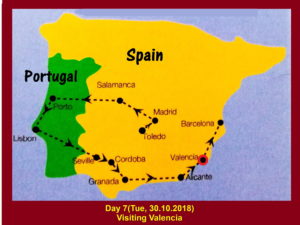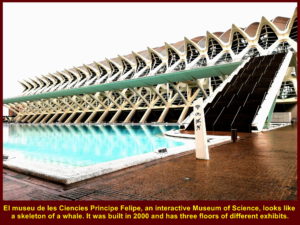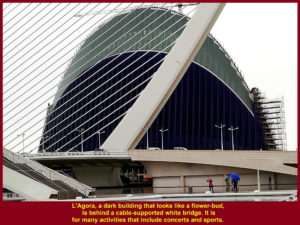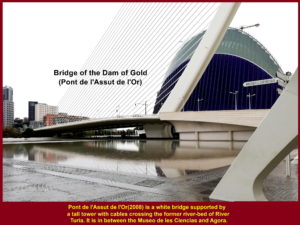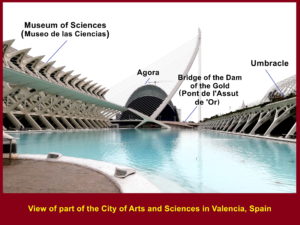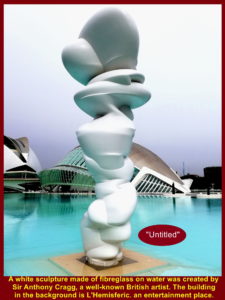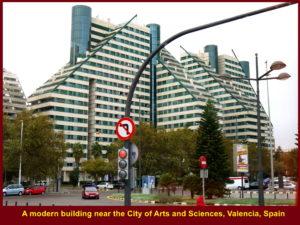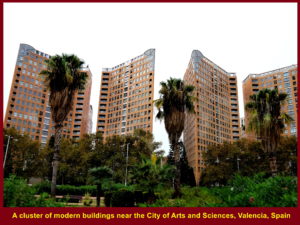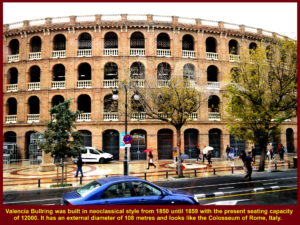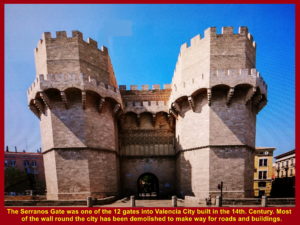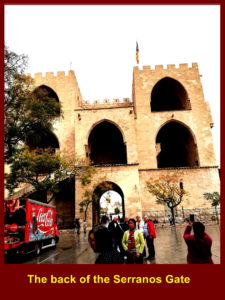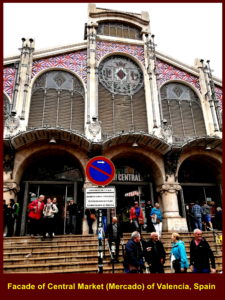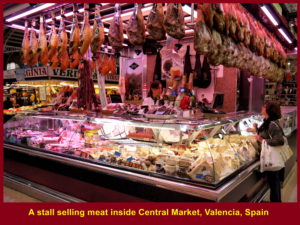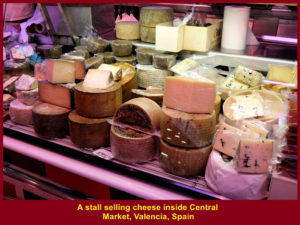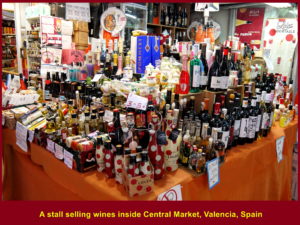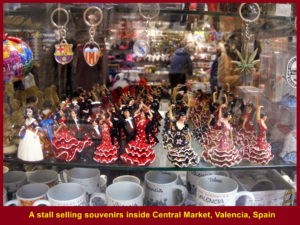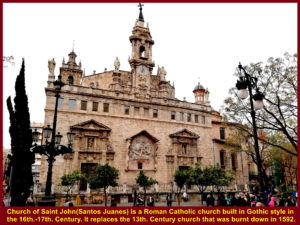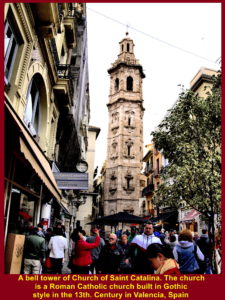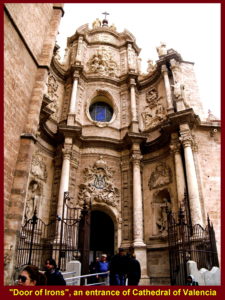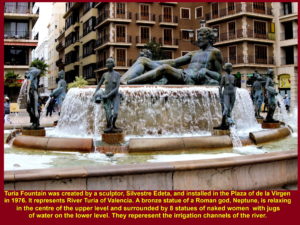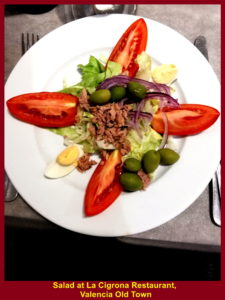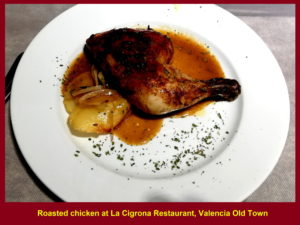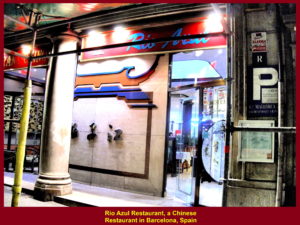Spain & Portugal Travel Part IX: Valencia
Spain & Portugal Travel Part IX: Valencia
Valencia
Day 9 Tuesday, 30 October 2018
On this day, we were going to visit Valencia.
In the morning, we left Hotel Port Elche in Alicante where we stayed the previous night and travelled 165 km north-east to Valencia. The journey would take 2 hours.
Valencia
Valencia is a large city of 800,000 inhabitants.
When we arrived at Valencia, we visited a modern place known as “Arts and Sciences City”.
Map showing the location of Valencia
Arts and Sciences City, Valencia
In 1957, Valencia City experienced a disastrous flood when the water of River Turia overflowed and flooded the city. Later, the river was diverted elsewhere and the dry river-bed in the city was converted to a unique, modern place known as “Arts and Sciences City”.
Plan of Arts and Sciences City
Arts and Sciences City has buildings built in modern architectural style designed by Santiago Calatrava and Felix Candela. Each building has one or more functions.
The plan of the place below shows the locations of the following buildings, Museum of Sciences, Agora, Umbracle and Hemisferic to name a few.
Plan of Arts and Sciences City
Some of the modern buildings are described below.
Museum of Sciences(Museo de les Ciencies)
Museum of Sciences looks like a whale skeleton built in 2000. It is an interactive museum that has three floors of different Science exhibits.
Museum of Sciences
Agora
Agora built in 2009 looks like a flower-bud and is used for many activities, including concerts, exhibitions, conventions and sports.
Agora
Umbracle
Umbracle built in 2001 looks like a bridge that is 320 metres long and 60 metres wide. Below it is a road but its top is a garden. The garden has more than 1000 plants of different species and sculptures, too.
Umbracle
Umbracle
Hemisferic
Hemisferic looks like an eye with an eyelid was built in 1998. It houses an IMAX cinema, planetarium and laserium.
Hemisferic
Hemisferic
Bridge of the Dam of the Gold(El Pont de l’Assut de l’Or)
This bridge was built in 2008 over the dry river-bed of River Turia. It is supported by a 125 metre high tower and cables.
Bridge of the Dam of the Gold
The photo below shows part of the Arts and Sciences City.
Part of Arts and Sciences City
Sculptures in Arts and Sciences City
There are several sculptures of different forms and sizes all over Arts and Sciences City, including the two shown below.
Bronze Sculpture
A bronze sculpture in a pool of water. It is known as “Mixed Feelings” which was created by a British artist, Anthony Cragg.
Bronze Sculpture
White Fibre-Glass Sculpture
Anthony Cragg created another sculpture that is made of fibre-glass and known as “Untitled”. It is erected in another pool of water.
White Fibre-Glass Sculpture
Modern Buildings near Arts and Sciences City
From the Arts and Sciences City, a visitor can see some modern residential buildings nearby, including the ones shown in the two photos below.
Modern Building
A Cluster of Modern Buildings
Journey to Valencia Old Town
When we were on our way to the Valencia Old Town from Arts and Sciences City, we passed by two landmarks, Valencia Bullring and the North Station as described below.
Valencia Bullring
Valencia bullring(Plaza de Toros de Valencia) was opened in 1859 and has a seating capacity of 12,000. It is built in Neoclassical style and looks like the Colosseum in Rome.
Valencia Bullring
The North Station(Estacio del Nord)
This attractive building is the main railway station of Valencia. It is built in Neoclassical style and opened in 1852.
The North Station
Serranos Gate
When we reached the Valencia Old Town, we got down from our coach and walked a short distance to the town.
On the way, we saw was an imposing gate of the town known as Serranos Gate.
There were twelve gates with walls round the old town built in the 14th. Century to protect it from foreign invaders. But now only two are left and a few parts of the old wall remain.
Below is the Serronos Gate that we came across and it is kept as a monument.
The Front of Serranos Gate
The Back of Serranos Gate
The Side of Serranos Gate
Central Market(Mercado)
Soon we arrived at the centre of the town and saw the largest market in Valencia. Known as Central Market or Mercado, it was built in Valencian Art Nouvema style at the old open-market site from 1914 until 1928.
Central Market
Facade of Central Market
Writer and Wife Visited Central Market
Interior of Central Market
Stalls in Central Market
The market is large and has over 100 stalls selling fruits, vegetables, meat, cheese, wine, souvenirs, etc.
Below are some photos showing different stalls at the market.
Meat Stall
Fruit Stall
Vegetable Stall
Cheese Stall
Wine Stall
Souvenir Stall
Historical Buildings
Coming out of Central Market, I saw some historical buildings in front, including two buildings described and shown in the photos below.
Stock Exchange Building(Llotja de la Seda)
Stock Exchange Building that looks like a castle is in front of Central Market. Built in Valencian Gothic style in the 15th. Century, it was the main trading centre in Valencia. Besides, it housed a marine merchant tribunal and prison for merchants who could not pay their debts in the olden days.
Now the building is a monument and tourist attraction.
Stock Exchange Building
Church of St. John(Santos Juanes)
Near the Stock Exchange is a church, Church of St. John. It is a Roman Catholic church built in Gothic style in the 16-17th, Centuries. It replaced the 13th. Century church that was burnt down in 1592.
Church of St. John
Church of Catalina
Having visited Central Market, we walked to a public square called Royal Square(Plaza de la Reina).
As we were walking to the square, we saw a church, Church of Catalina which is a Roman Catholic church. It was built in Gothic style in the 13th. Century. Adjacent to the church is a bell-tower of five levels with a hexagonal base. It was built in Baroque style between 1688 and 1795.
Church of Catalina
Royal Square(Plaza de la Reina)
When we were in an open space known as Royal Square, we noticed that it was a busy business-place surrounded by Cathedral of Valencia, Octagonal Bell-Tower, restaurants, shops, hotels, etc.
Royal Square
Virgin Mary Square
Then we walked to another open space nearby called Virgin Mary Square. In this square, there are two well-known historical buildings, viz. Cathedral of Valencia and Basilica of Our Lady of the Abandoned(Virgen de los Desamparados).
Virgin Mary Square
The photos below show the two historical buildings in Virgin Mary Square.
Cathedral of Valencia or Saint Mary’s Cathedral
Cathedral of Valencia or Saint Mary’s Cathedral is a Roman Catholic church built in Gothic style in the 13th. Century. There is a tall, octagonal bell tower built behind the church.
Cathedral of Valencia
“Door of Irons”, the Main Entrance of the Cathedral
Basilica of Our Lady of the Abandoned(The Virgen de los Desamparados)
A basilica built in Renaissance-Baroque style is close to Cathedral of Valencia. It was constructed from 1652 until 1666.
Basilica of Our Lady of the Abandoned
In the centre of Virgin Mary Square there is a fountain known as Turia Fountain that represents River Turia of Valencia.
Turia Fountain
On the upper level of the fountain is a bronze statue of Neptune, a Roman god, relaxing and enjoying the flowing water. He is surrounded by eight bronze statues of naked women pouring water out of their jugs on the lower level. They represent the eight irrigation channels in agricultural lands of Valencia.
Turia Fountain
Lunch in Valencia Old Town
When we left Virgin Mary Square we went to a Spanish restaurant, La Cigrona Restaurant, in the Valencia Old Town to have lunch.
La Cigrona Restaurant
Food for Lunch
Below are two photos showing some of the food we ate at the restaurant.
Salad
Roasted Chicken
Next Destination
After the delicious meal in Valencia, we left for another destination which was Barcelona, 350 km in the north-east and the journey would take 4 hours.
On arrival in Barcelona in the evening, we went to a Chinese restaurant, Rio Azul Restaurant, to have dinner and then stayed at a hotel, Sercotel Ciutat da Montcada, for a night.
We would be visiting the heritage sites in Barcelona on the following day.
Rio Azul Restaurant
Sercotel Ciutat de Montcada, Barcelona
Previous(Granada) / Home / Next(Barcelona)
Places visited during Spain & Portugal Tour(22 Oct-02 Nov 2018):
Toledo Madrid Salamanca Porto Lisbon Seville Cordobo Granada Valencia Barcelona

